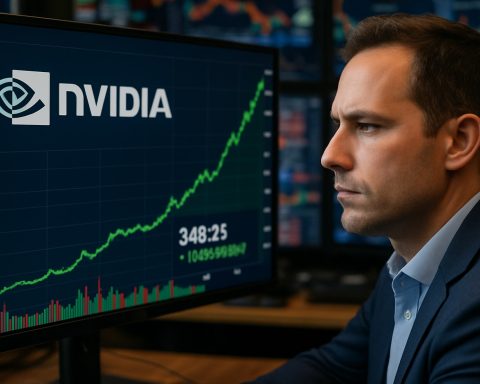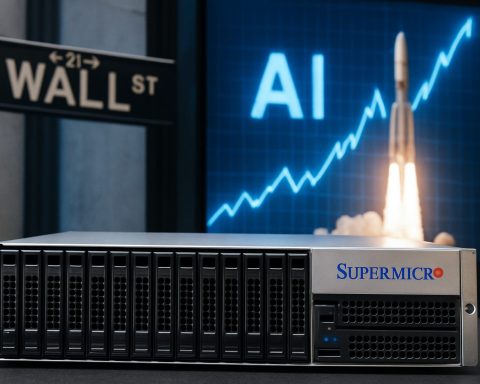- Nvidia’s GPUs have become crucial to data centers, fueling the company’s rapid growth to $130 billion in annual revenue.
- Despite a 19% stock drop due to geopolitical and market pressures, Nvidia’s data center revenue surged by 93% year-over-year.
- The Blackwell computing system generated $11 billion in quarterly revenue, driven by the rising demand for AI inferencing.
- Nvidia faces competition from potential new entrants like OpenAI, which may develop its own AI chips.
- High profit margins (56%) and chip restrictions in China pose opportunities and challenges.
- Major tech companies like Google and Amazon depend on Nvidia’s GPUs, underpinning its market strength.
- At a P/E ratio of 24, Nvidia shares may be undervalued compared to the average of 80, offering potential investment opportunities.
- Nvidia’s innovation and market leadership position it strongly for future AI advancements.
Nvidia stands as a Goliath in the tech arena, its GPUs becoming as essential to data centers as oxygen is to the atmosphere. The chipmaker’s journey from $4.7 billion in annual revenue a decade ago to a staggering $130 billion paints a vivid picture of relentless growth. However, the blistering ascent has recently encountered an unexpected air pocket.
Amid a whirlwind of geopolitical tensions and unsettling market tremors, Nvidia faced a stock drop that could give even the most stoic investor pause. The first quarter of the year saw its share price sink by 19%, as whispers of tariffs and competitive threats loomed like storm clouds on the horizon. Yet, in this moment of volatility, Nvidia remains a company in demand, with fiscal fourth-quarter data center revenues surging by 93% year-over-year—a testament to its stronghold in a landscape hungry for AI breakthroughs.
Nvidia’s secret weapon, the cutting-edge Blackwell computing system, reported a jaw-dropping $11 billion quarterly revenue. The insatiable demand for these systems promises further growth, especially as AI inferencing—the sophisticated task of anticipating computational needs—becomes the next battlefield. Here, Nvidia is not just battling for survival but aiming to dominate, designing chips capable of handling tasks demanding 100 times more processing power.
However, the path ahead isn’t without pitfalls. Intense competition simmers beneath the surface, with reports of OpenAI potentially crafting its own AI chips to loosen the Nvidia grip. And even as Nvidia boasts an extraordinary 56% profit margin, this sky-high pricing model might drive partners to explore more economical alternatives.
Yet, not all challenges are a reason for retreat. While chip restrictions in China present a roadblock, Nvidia’s strength is its diversity of markets. Heavyweights like Google and Amazon continue to rely on Nvidia’s unparalleled GPU prowess, reinforcing the chipmaker’s role as the backbone of modern AI applications.
Investors now face a crucial decision point. With Nvidia stock priced at around 24 times this year’s consensus earnings, a significant dip from its average P/E ratio of 80, the shares whisper of potential undervaluation. The current storm clouds could either morph into a perfect tempest or clear out to reveal a rich harvest of value for those bold enough to stake their claim.
So, should you clutch onto Nvidia shares amidst the market’s erratic dance? While risks dart from multiple angles, one fact remains crystalline: Nvidia’s foundation is robust, its innovation relentless, and its market position enviable. Savvy investors might find this turbulence a ripe opportunity, albeit one that demands vigilance.
In a world increasingly driven by AI’s push into the future, Nvidia appears well-poised—not just as a passenger, but as a steering hand on the helm.
Nvidia’s Phenomenal Journey: A Blend of Opportunity and Challenge in the Tech Arena
Unpacking Nvidia’s Meteoric Rise and Challenges
Nvidia’s ascent from a $4.7 billion revenue a decade ago to $130 billion today is a story of relentless innovation and market dominance. As Nvidia navigates a landscape rife with challenges and opportunities, several factors and market dynamics position the company uniquely in the tech ecosystem.
Key Factors Driving Nvidia’s Success
1. AI Integration and GPU Dominance:
Nvidia’s role in AI advancements is unparalleled, with its Graphics Processing Units (GPUs) becoming essential in fields ranging from gaming to data center operations. The adoption of AI and machine learning across industries has fueled increased demand for Nvidia’s cutting-edge hardware, making it a keystone for tech infrastructure.
2. Blackwell Computing System:
The introduction of Nvidia’s Blackwell computing system, which reportedly generated $11 billion in quarterly revenue, underscores the company’s ability to capture substantial market interest quickly. This system is tailor-made for AI inferencing tasks, a growing need in modern technology frameworks.
3. Strategic Partners and Market Reach:
Despite geopolitical tensions, Nvidia’s diverse market presence, notably with collaborations with giants like Google and Amazon, fortifies its market reach. This wide footprint mitigates risks associated with regional instabilities.
Emerging Challenges and Competitive Threats
1. Geopolitical Pressures:
Recent geopolitical tensions have impacted Nvidia’s stock valuation, causing a 19% dip in share price. Trade tariffs and chip restrictions, especially concerning China, are potential hurdles in Nvidia’s supply chain and revenue growth streams.
2. Increasing Competition:
Speculation about OpenAI developing proprietary AI chips highlights growing competition, which could disrupt Nvidia’s stronghold in the high-performance computing realm. New players challenging Nvidia’s pricing model could shift market dynamics considerably.
3. Market Valuation and Investor Sentiment:
With shares priced at 24 times this year’s earnings, compared to an average P/E ratio of 80, Nvidia might appear undervalued. This valuation can attract investors seeking long-term growth, but it also indicates market volatility and the need for cautious market engagement.
Key Questions for Potential Investors
– Is the current valuation an opportunity or a sign to be cautious?
Nvidia’s lower-than-average P/E ratio suggests potential undervaluation. However, investors must weigh this against market volatility caused by geopolitical tensions and emerging competitors.
– How stable are Nvidia’s premium profit margins?
Nvidia maintains an impressive 56% profit margin, but competitive pressures might necessitate a reevaluation of pricing strategies to maintain market leadership.
– What is the future potential for Nvidia amid AI advancements?
As AI becomes more embedded in daily applications, Nvidia is well-positioned to steer growth, particularly with its innovations in GPU technology and AI specialization.
Actionable Recommendations
– Diversify Investments:
Investors should consider diversifying their portfolio to balance Nvidia’s potential high returns with investments in other technology sectors.
– Keep Abreast of Market Trends:
Regularly review technology trend reports and geopolitical news to make informed decisions regarding Nvidia stock investments.
– Monitor AI Developments:
Stay updated on AI developments and Nvidia’s strategic partnerships to better understand the evolving landscape and Nvidia’s role in it.
For more insight into Nvidia’s trajectory and market contributions, visit the official Nvidia website.
With Nvidia holding a vital role in today’s AI-driven advancements, the company offers boundless potential for innovation, albeit with meticulous navigation through market complexities.








